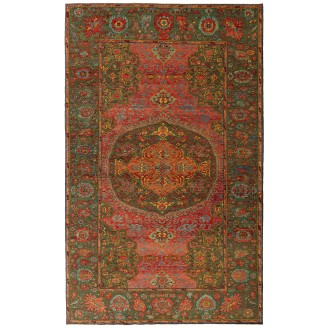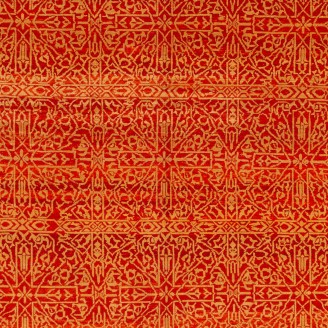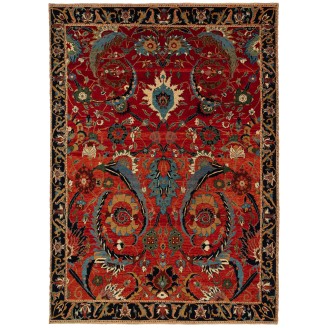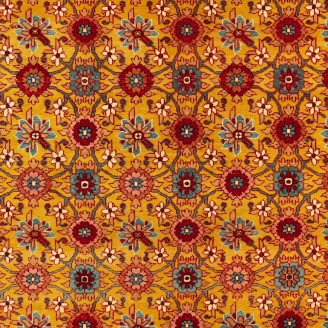Model: ART00037
Dimensions: 8'1" X 9'10"(248cm x 302cm)
The source of the rug comes from the book Völker, Angela, Die orientalischen Knüpfteppiche das MAK, Vienna: Böhlau, 2001: 42–5. This rug with the central star was designed in the early 16th-century rug by Mamluk Sultane of Cairo, Egypt. It is exhibited at MAK – Museum of Applied Arts, Vienna Austria..
Price:
$22,500
Ex Tax:$22,500
Model: ART00586
Dimensions: 7'6" X 4'8"(231cm x 143cm)
The source of the rug comes from the book Renaissance of Islam, Art of the Mamluks, Esin Atil, Smithsonian Institution Press, Washington D.C., 1981 nr.125. This a rug with a cup motif design, a late 15th-century rug from Mamluk Sultane of Cairo, Egypt. It is exhibited at the Washington D.C. The..
Price:
$6,600
Ex Tax:$6,600
Model: ART00445
Dimensions: 5'10" X 9'3"(179cm x 282cm)
The source of the rug comes from the book Orient Star - A Carpet Collection, E. Heinrich Kirchheim, Hali Publications Ltd, 1993 nr.75. This offset pattern is composed of ascending shield-like palmettes flanked by leaf-like wings designed for 17th to 18th-century rugs from Azerbaijan, the North-west ..
Price:
$11,000
Ex Tax:$11,000
Model: ART00264
Dimensions: 5'11" X 6'11"(181cm x 213cm)
The source of the carpet comes from the book Oriental Rugs in the Metropolitan Museum of Art, Dimand, Maurice S., and Jean Mailey, The Metropolitan Museum of Art, New York 1973 fig.90. If the so-called vase-technique carpets represented the triumph of Safavid workshop weaving in the seventeenth cent..
Price:
$8,800
Ex Tax:$8,800
Model: ART00610
Dimensions: 5'6" X 7'8"(170cm x 235cm)
The source of the rug comes from the book Orient Star - A Carpet Collection, E. Heinrich Kirchheim, Hali Publications Ltd, 1993 nr.17. This is a remarkable and very unusual swastika designed early 19th-century rug from the Central Caucasia area. This unusual pattern is not known on ot..
Price:
$6,950
Ex Tax:$6,950
Model: ART00183
Dimensions: 5'1" X 7'10"(156cm x 240cm)
This unique design rug is interpreted by our designers with a composition of pictorial western-style life.Color summary: 17 colors in total, most used 4 colors are; Misty Moss 14 (Spurge - Madder Root) Scarlet 5 (Madder Root) Dark Brown 316 (No Dye - Sheep’s own Color) Jericho Jade 25 (Spurge ..
Price:
$4,800
Ex Tax:$4,800
Model: ART00675
Dimensions: 9'9" X 6'10"(298cm x 210cm)
The Kerman Vase-Technique Carpet (Model: ART00675) by Ararat Rugs is a distinguished creation inspired by the renowned 16th-century Kerman "Vase" carpets of southeastern Persia. This piece embodies the elegance and sophistication characteristic of Persian court art from that era.A poetic reinterpret..
Price:
$25,200
Ex Tax:$25,200
Model: ART00599
Dimensions: 8'0" X 13'2"(245cm x 402cm)
The source of the carpet comes from the book How to Read – Islamic Carpets, Walter B. Denny, The Metropolitan Museum of Art, New York 2014 fig.58 and Antique Rugs from the Near East, Wilhelm von Bode and Ernst Kühnel, Klinkhardt & Biermann, Berlin 1958, pg.40 and Oriental Carpets in the Museum o..
Price:
$29,800
Ex Tax:$29,800
Model: ART00144
Dimensions: 4'10" X 9'10"(149cm x 300cm)
The source of the rug comes from the book Renaissance of Islam, Art of the Mamluks, Esin Atil, Smithsonian Institution Press, Washington D.C., 1981 nr.125. This a rug with a cup motif design late 15th-century rug from Mamluk Sultane of Cairo, Egypt. It is exhibited at the Washington D.C. The Textile..
Price:
$7,700
Ex Tax:$7,700
Model: ART00180
Dimensions: 5'2" X 8'9"(160cm x 268cm)
This rug has an interpreted design composed of a geometric lattice pattern taken from a part of the Mamluk rug, filling the field elegantly, has the impression that it is only part of a larger scheme designed 15th-century rug from the Mamluk era, Cairo region, Eygpt. Mamluk carpets originated in a p..
Price:
$7,400
Ex Tax:$7,400
Model: ART00578
Dimensions: 4'7" X 6'7"(142cm x 201cm)
This Gabbeh rug, designed in the 1930s, is a type of handwoven rug that originated from Iran, specifically from the southwestern region known as Fars. The word "Gabbeh" itself means "raw" or "natural" in Persian, reflecting the simplicity and primitive charm of these rugs. Gabbeh rugs are traditiona..
Price:
$2,860
Ex Tax:$2,860
Model: ART00516
Dimensions: 6'8" X 7'9"(205cm x 238cm)
This offset pattern is composed of palmettes and flowers, one has the impression that it is only part of a larger scheme designed 19th-century rug from the Bidjar region, Eastern Kurdistan area. Very similar palmettes, drawn in a curvilinear manner and combined with identical forked leaves, can be s..
Price:
$9,300
Ex Tax:$9,300
Model: ART00401
Dimensions: 5'5" X 7'4"(166cm x 224cm)
The source of the carpet comes from the book How to Read – Islamic Carpets, Walter B. Denny, The Metropolitan Museum of Art, New York 2014 fig.46-47 and Orientel Rugs, Volume 4 Turkish, Kurt Zipper and Claudia Fritzsche, Antique Collectors' Club, 1989 nr.82. This 16th-century deeply serrated eight-l..
Price:
$4,200
Ex Tax:$4,200
Model: ART00330
Dimensions: 4'3" X 6'9"(131cm x 208cm)
The source of the rug comes from the book Antique Rugs of Kurdistan A Historical Legacy of Woven Art, James D. Burns, 2002 nr.40. This offset pattern is composed of palmettes and stems with large forked leaves, one has the impression that it is only part of a larger scheme designed 17th-century rug ..
Price:
$5,300
Ex Tax:$5,300
Model: ART00394
Dimensions: 6'1" X 9'8"(187cm x 297cm)
The source of the rug comes from the book Islamic Carpets, Joseph V. McMullan, Near Eastern Art Research Center Inc., New York 1965 nr.28. This Persian Garden design rug belongs to the second half 18th century from the Persia area. The design of this rug is based on the Formal Persian Garden. There ..
Price:
$12,000
Ex Tax:$12,000
Model: ARTK0002
Dimensions: 7'9" X 10'8"(238cm x 326cm)
This is a with a central medallion carpet design 19th century from Garrus ( Gerous or Garus ) region, Eastern Kurdistan area. Garrus is located in the foothills approaching the flatlands of Persia, Garrus has been a significant Kurdish city since antiquity when it was the capital of Media Minor. Imp..
Price:
$29,000
Ex Tax:$29,000
Model: ART00103
Dimensions: 1'8" X 3'1"(52cm x 95cm)
The most dramatic of the Gerous ( Garrus, Gerus, Garus ) carpets are those with an "asymmetric" design. Only a section of the original is shown, in the same way, many Lotto carpets were woven. It is difficult to guess the size of these carpets from a photo, but here we enter the area of the "Wagireh..
Price:
$850
Ex Tax:$850
Model: ART00269
Dimensions: 5'6" X 7'11"(169cm x 243cm)
The source of the rug comes from the book Orient Star - A Carpet Collection, E. Heinrich Kirchheim, Hali Publications Ltd, 1993 nr.79. This is unusual design 18th or 19th century rug from Khila, Kuba region East Caucasus area. Very similar palmettes, drawn in a curvilinear manner and combined with i..
Price:
$7,600
Ex Tax:$7,600
Model: ART00528
Dimensions: 8'2" X 11'5"(250cm x 350cm)
The source of carpet comes from the book Museo Calouste Gulbenkian, Printed by Gulbenkian Museum Lisbon, in 2015, nr.52. This is a vase-technique carpet design in the 17th century in the Kerman region, of Persia. In the 16th century, in Safavid Persia, medallion rugs were among the most appreciated,..
Price:
$32,000
Ex Tax:$32,000
Model: ART00527
Dimensions: 4'9" X 5'5"(146cm x 166cm)
The source of the rug comes from the possession of Endre Unger, which was sold at Sotheby’s in 1992. That rug with the central star was designed in the early 16th-century rug by Mamluk Sultane of Cairo, Egypt. The interpreted design is composed of Jerrehian rug's border motifs lattice, covering the ..
Price:
$3,800
Ex Tax:$3,800
Model: ART00305
Dimensions: 6'7" X 9'3"(202cm x 283cm)
The source of the rug comes from the book Antique Rugs of Kurdistan A Historical Legacy of Woven Art, James D. Burns, 2002 nr.2. This was an exclusive example of a Mina Khani lattice design mid-19th century rug from Koliya'i, Southern Kurdistan area. The mina khani is composed of a series of rows of..
Price:
$16,600
Ex Tax:$16,600









































